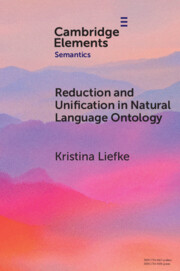Element contents
Reduction and Unification in Natural Language Ontology
Published online by Cambridge University Press: 11 December 2024
Summary
- Type
- Element
- Information
- Series: Elements in SemanticsOnline ISBN: 9781009559683Publisher: Cambridge University PressPrint publication: 16 January 2025
References
- 1
- Cited by

